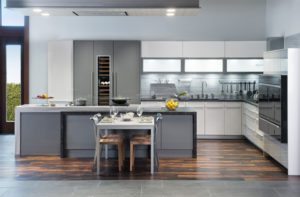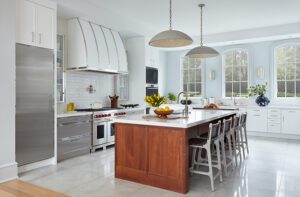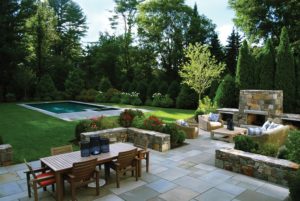Jim M-Geough
February 21, 2011
Photography by Portrait by Webb Chappell
For decades a very familiar face in the New England design trade, Jim M-Geough (along with his wife, Susan) owns and operates one of the larger showrooms at the Boston Design Center. Now home to some twenty-five or more lines of furniture, lighting, window shades and accessories, as well as European and Asian antiques, the M-Geough Company has been a player on our regional scene since 1951.
Kyle Hoepner: Speaking for the public, Jim, what is it, exactly, that design showrooms like M-Geough do? How does the process of working with a showroom go?
Jim M-Geough: We’re a to-the-trade showroom, which means we work with the public only through designers and/ or architects. So what we bring to the game is becoming a team member with the designer to find the correct products. Everything we do is pretty much custom. All the manufacturers we represent are privately owned. The owners show up every day, they’re entrepreneurs, as we are. They love what they do, they have a passion about the industry and their work is only available through trade showrooms like ours—they offer products that can’t be found in retail stores, with few exceptions.
KH: So your personal relationships with the manufacturers and suppliers help make sure that the quality is kept and that all of the Ts are crossed and the Is are dotted?
JM: And that things are ordered correctly and shipped correctly. We follow through right until the very end. Because these products are not inexpensive. They’re custom made, so they can be very costly, and you don’t want to have a warehouse full of things that didn’t go right.
KH: And, presumably, the makers of these products see some advantage in working in this way, too, rather than just putting things out in stores.
JM: Oh, absolutely. In most stores, what you see is what there is. Here, a designer comes in and sees a table and says, “I love that round table, but I really want a rectangular one, and I don’t want it in walnut, I want it Santos rosewood.” That’s where we shine. We say, fine, we can do all of the above. We can provide a CAD drawing and samples of finishes, and the consumer gets to see everything all the way through. It’s a process that’s really enjoyable for them because they’re creating something, along with their designer, for their own home. The designers are creating an environment, and they need people like us to help them do their custom work. Having been in the business as long as we have, we know what’s going to work and what’s not going to work. We solve problems before they end up in the home and clients get upset.
KH: How did you get into this business?
JM: I came to work for my dad, who owned the original business, in September of 1969. I was in construction before that and thought I’d give this a try. So I came in in ’69 and I said, “Well, I’ll give this a couple of years and see what happens.” Forty-plus years later I’m still seeing what happens!
KH: Are there specific things typical of New England that affect how you operate or what you carry? Has being located in Boston had an important influence on your business?
JM: There’s a group of guys with businesses like ours in other parts of the country—they’ve been my friends for forty years, we’re very close and we get together for a week every year to talk about business approaches and how to do this the best way possible. One of them is in Texas. We do a lot of similar things but we have to do them on a different scale, in different colors and textures. Texas and New England are night and day, and although the identical basic table might go into our houses, if he does it in oak I’ll do it in a fruitwood. But we also swap things back and forth all the time. If I have a line that I think would work well for him, I get him involved, and he gets that line. If he has a line that he thinks would work well for me, I get that line.
KH: There’s actually one big difference between this type of business and a retail shop—when you order a piece, you’re not necessarily ordering the entire finished thing from just one company. If you buy a sofa through M-Geough, for instance, the upholstery fabric will be purchased separately from a different showroom.
JM: Right.
KH: So it’s a bit more complex . . .
JM: It is, there’s a lot going on that way. When you buy a custom table, we may say, “Okay, we have to go to the veneer house.” We have one manufacturer who sometimes comes out and meets the client and then goes to the veneer house and hand selects the veneer for the client, because it’s an exotic or its something they want that’s very unique. And only then do we start to produce the table. We’re all but cutting the trees down.
KH: . . . but the advantage, of course, is that the client ends up with an entirely personalized piece.
JM: Exactly. And it’s built to their needs. That’s where the designer comes in. Our team and the designer can walk a consumer through the process.
KH: Have you seen changes in the design business over time—how things get done, how designers work, how the clients and the designers interact with you?
JM: I would describe it as a work in progress always. In the days when I first started, Providence and Boston, Hartford and Portland and Worcester all had three or four or five really great designers. Today, there are a lot more designers, and they’re educated about design; it’s a very serious business for them. The other thing is the consumer. Many times, before the consumer even comes in here, they’ve been on our Web site, they’ve read about who and what we are.
KH: So there’s more design awareness in general?
JM: I remember a great old designer saying to a client, “Just sit there, I’ll pick the pieces out and show them to you near the end.” That’s not happening today, and that’s a good thing. The home environment is a very important part of people’s lives, and the consumer is really much more educated today, in terms of looking at products and asking questions. The question we get most often is, “Why is this so expensive?” We can answer that very easily—it’s the quality and the time involved. If a gentleman is a driving a BMW and is complaining about the price of a dining table, I might say, “Well, you’ll go through ten BMWs before you get rid of that dining table.” It’s a perceived value.
KH: Where do you see things going from here?
JM: The million-dollar question.
KH: For the world, for design, for Jim M-Geough!
JM: I think the retail side of the home furnishings business has gone so that there are the deals and the discounts and the plasma TVs with everything, and then there is us—there’s not a lot in the middle. I think there’s always going to be a need for our kind of product, for the people who really care. So I think we’ll always have a designer showroom.
Share
![NEH-Logo_Black[1] NEH-Logo_Black[1]](https://www.nehomemag.com/wp-content/uploads/2022/08/NEH-Logo_Black1-300x162.jpg)







